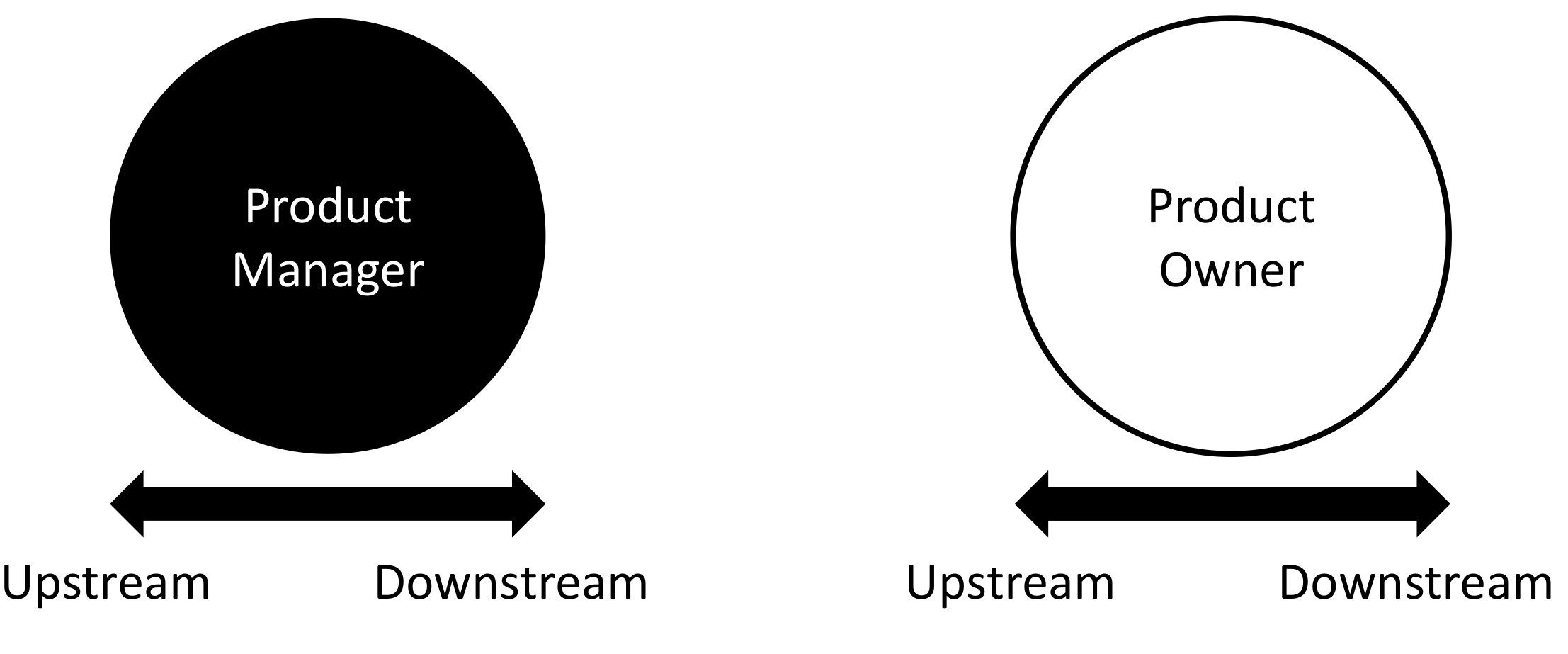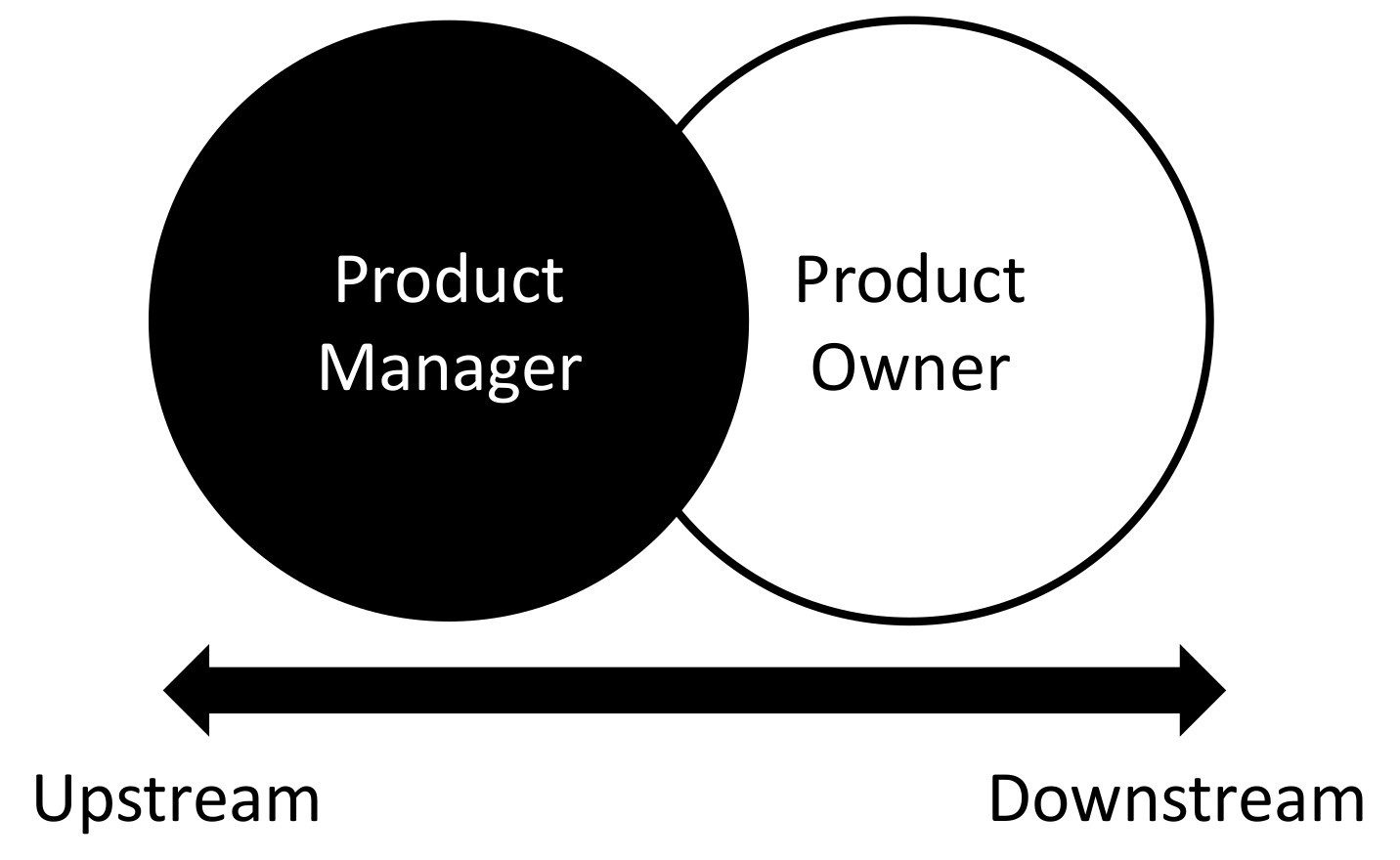
Product Manager vs Product Owner
Closely aligned are the product manager and product owner roles. In some instances they are interchangeable and it’s not clear how or if the 2 are different – let’s take a closer look at the two to help define the similarities and differences and how you go about selecting the right one for you.
By thinking about upstream and downstream responsibilities, it is possible to describe and represent the 2 roles standalone and working alongside each other.
“Upstream responsibilities are closer to the customer
and stakeholders, while downstream activities are closer to the
development and delivery of products.”
Upstream responsibilities can be considered to be those that are closer to the customer and stakeholders, while downstream activities are closer to the development and delivery of products. Let’s start with upstream responsibilities.
Upstream responsibilities
Upstream responsibilities can include:
- Understanding the business context and focus and align the product to this
- Creating the product vision, objectives, strategy and roadmap incl. proposition development, business cases and KPIs
- Being the domain expert and product evangelist
- Creating and communicate a product story that your team and stakeholders can and do buy into
- Being the customer advocate that continuously places the customer at the heart of all product decisions
- Developing deep customer, product and domain knowledge and expertise incl. capturing and understanding customer, market and competitor trends and analysis, and use this to create commercial opportunities
- Developing and manage an outcome-led roadmap that results in continuous product enhancements that deliver against the product vision and objectives
- Using user research techniques to create draft products and features e.g. wires, mock-ups etc.
- Setting up and run experiments to identify opportunities to enhance the customer experience and deliver against objectives
- Capturing and analyse internal and external data to support decision making
- Collaboratively working with and engage the core team (incl. engineering and UX) and stakeholders (incl. sales/business development, marketing, partners, suppliers, communities, etc.) to create and deliver end-to-end solutions to customer problems
- Identifying, engaging, managing, influencing, chivvy along and collaborating with stakeholders
- Openly communicating with the team and all stakeholders
- Developing material and kits to support sales and marketing
- Reporting on product performance to the team and stakeholders
- Managing requests, investment and tracking of product budgets
- Managing 3rd party partner and supplier relationships
Downstream responsibilities
Downstream responsibilities can include:
- Leading requirement gathering and write user stories, manage the product backlog incl. writing cards, prioritising, setting release cycles, running stand-ups, leading planning games, showcases and retrospectives
- Running experiments
- Working with experimentation techniques such as A/B and multi-variant testing to identify scalable solutions to customer problems
- Capturing and interpret customer and product insights and use to drive the product forward
- Using data, insights and metrics to make sense of the incomprehensible, solve problems, drive and support decision making
- Investigating opportunities, issues and problems and lead the team to a resolution
- Working with Agile methodologies
- Understanding the technology stack and its core components across all platforms
- Managing the use of budgets development budgets
- Managing delivery plans and timelines
If there is one product manager or owner, then they will complete both up and downstream activities (see below).

However, if there is one of each, I would expect the product manager to complete the upstream activities, while the downstream activities will sit with the product owner (see below).

Shared skills and competencies
Whether product manager or owner, in order to effectively complete these activities, you must have skills and competencies such as:
- Bias for action
- Can do attitude
- Curious, investigative and learning mind
- Data driven and analytical
- Problem solver
- Stakeholder management
- Commercial acumen
- People skills
- Communication
- Influence and persuasion
- Ability to sell an idea
- Flexibility and adaptability
- Be able to make a decision and stand by it
- Emotional intelligence and empathy
- Technical expertise or at least knowledge and understanding.
Selecting the one for you
Decisions about which role (product manager, product owner or both) is most appropriate, need to start by thinking about the task to be completed – once finished the job role(s) should be designed. For instance, if the role requires a lot of time to be spent away from the team (say with partners or working with stakeholders), then a separate product owner role should be considered. Whereas if the role means the same person can manage the end-to-end process on their own, then one person with either job title (preferably product manager) should be sufficient.
If the work is ample, consideration should go beyond trying to make do by stretching people to manage both (for example constantly asking someone (e.g. a BA) to be a quasi-product manager to cover). Here you should look at realigning the product into small enough chunks that one person can complete.
“…the choice of product manager or product
owner is less important than being clear about
the activities the role performs.”
Ultimately, the choice of product manager or product owner as the title for this product role is less important than being clear about the activities the role performs. More about these two roles and other product management roles can be found in my book ‘Product Management: Mastering the Product Role’.
Asomi Ithia is a Product Guy, author of the Product Management Series of Books, Co-organiser of Product Group London and a Mentor.
Let’s work together.
Product Manager vs Product Owner
Closely aligned are the product manager and product owner roles. In some instances they are interchangeable and it’s not clear how or if the 2 are different – let’s take a closer look at the two to help define the similarities and differences and how you go about selecting the right one for you.
By thinking about upstream and downstream responsibilities, it is possible to describe and represent the 2 roles standalone and working alongside each other.
“Upstream responsibilities are closer to the customer and stakeholders, while downstream activities are closer to the development and delivery of products.”
Upstream responsibilities can be considered to be those that are closer to the customer and stakeholders, while downstream activities are closer to the development and delivery of products. Let’s start with upstream responsibilities.
Upstream responsibilities
Upstream responsibilities can include:
- Understanding the business context and focus and align the product to this
- Creating the product vision, objectives, strategy and roadmap incl. proposition development, business cases and KPIs
- Being the domain expert and product evangelist
- Creating and communicate a product story that your team and stakeholders can and do buy into
- Being the customer advocate that continuously places the customer at the heart of all product decisions
- Developing deep customer, product and domain knowledge and expertise incl. capturing and understanding customer, market and competitor trends and analysis, and use this to create commercial opportunities
- Developing and manage an outcome-led roadmap that results in continuous product enhancements that deliver against the product vision and objectives
- Using user research techniques to create draft products and features e.g. wires, mock-ups etc.
- Setting up and run experiments to identify opportunities to enhance the customer experience and deliver against objectives
- Capturing and analyse internal and external data to support decision making
- Collaboratively working with and engage the core team (incl. engineering and UX) and stakeholders (incl. sales/business development, marketing, partners, suppliers, communities, etc.) to create and deliver end-to-end solutions to customer problems
- Identifying, engaging, managing, influencing, chivvy along and collaborating with stakeholders
- Openly communicating with the team and all stakeholders
- Developing material and kits to support sales and marketing
- Reporting on product performance to the team and stakeholders
- Managing requests, investment and tracking of product budgets
- Managing 3rd party partner and supplier relationships
Downstream responsibilities
Downstream responsibilities can include:
- Leading requirement gathering and write user stories, manage the product backlog incl. writing cards, prioritising, setting release cycles, running stand-ups, leading planning games, showcases and retrospectives
- Running experiments
- Working with experimentation techniques such as A/B and multi-variant testing to identify scalable solutions to customer problems
- Capturing and interpret customer and product insights and use to drive the product forward
- Using data, insights and metrics to make sense of the incomprehensible, solve problems, drive and support decision making
- Investigating opportunities, issues and problems and lead the team to a resolution
- Working with Agile methodologies
- Understanding the technology stack and its core components across all platforms
- Managing the use of budgets development budgets
- Managing delivery plans and timelines
If there is one product manager or owner, then they will complete both up and downstream activities (see below).

However, if there is one of each, I would expect the product manager to complete the upstream activities, while the downstream activities will sit with the product owner (see below).

Shared skills and competencies
Whether product manager or owner, in order to effectively complete these activities, you must have skills and competencies such as:
- Bias for action
- Can do attitude
- Curious, investigative and learning mind
- Data driven and analytical
- Problem solver
- Stakeholder management
- Commercial acumen
- People skills
- Communication
- Influence and persuasion
- Ability to sell an idea
- Flexibility and adaptability
- Be able to make a decision and stand by it
- Emotional intelligence and empathy
- Technical expertise or at least knowledge and understanding.
Selecting the one for you
Decisions about which role (product manager, product owner or both) is most appropriate, need to start by thinking about the task to be completed – once finished the job role(s) should be designed. For instance, if the role requires a lot of time to be spent away from the team (say with partners or working with stakeholders), then a separate product owner role should be considered. Whereas if the role means the same person can manage the end-to-end process on their own, then one person with either job title (preferably product manager) should be sufficient.
If the work is ample, consideration should go beyond trying to make do by stretching people to manage both (for example constantly asking someone (e.g. a BA) to be a quasi-product manager to cover). Here you should look at realigning the product into small enough chunks that one person can complete.
“…the choice of product manager or product owner is less important than being clear about the activities the role performs.”
Ultimately, the choice of product manager or product owner as the title for this product role is less important than being clear about the activities the role performs. More about these two roles and other product management roles can be found in my book ‘Product Management: Mastering the Product Role’.
Asomi Ithia is a Product Guy, author of the Product Management Series of Books, Co-organiser of Product Group London and a Mentor.

